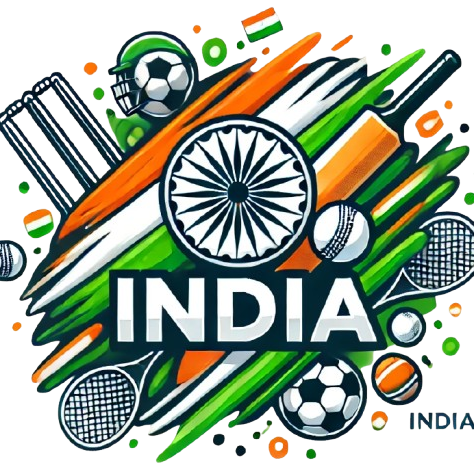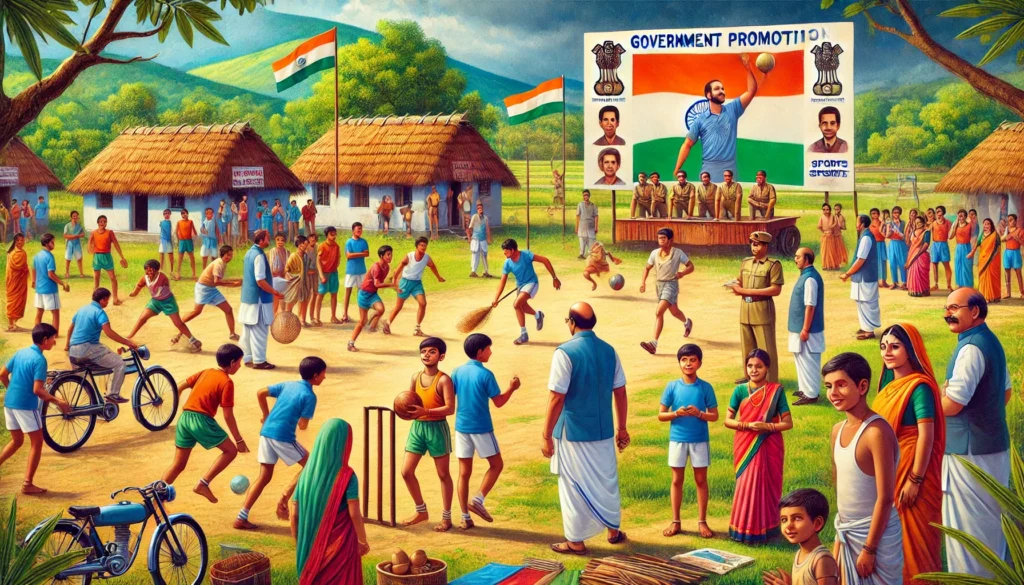Sports development in rural India is crucial for the overall growth of the country’s athletic potential. The rural areas of India, home to a vast population, possess a treasure trove of untapped talent. However, due to a lack of infrastructure, financial resources, and exposure, many young athletes from these regions remain unnoticed. Recognizing this potential, the Indian government has launched several initiatives aimed at promoting sports and nurturing young talent in rural communities. These programs focus on improving access to sports facilities, providing financial support, and offering specialized training. The emphasis on grassroots development is essential not only for identifying future stars but also for promoting health and discipline among youth in rural areas. By targeting regions that have historically been underrepresented in sports, the government aims to create a more inclusive sports culture, ensuring that all athletes, regardless of their background, have the opportunity to pursue their passion and excel.
Key Government Initiatives for Sports Development in Rural Areas
To bridge the gap between urban and rural areas in sports development, the Indian government has introduced a range of programs specifically designed to uplift the rural sporting ecosystem. These initiatives aim to provide better facilities, training, and opportunities for young athletes who may otherwise lack access to resources. Here are some of the most impactful programs:
Khelo India: Empowering Youth through Sports
The Khelo India initiative, launched in 2018, has been one of the most significant efforts by the Indian government to promote sports at the grassroots level. It focuses on identifying talent in rural and underserved regions, offering them a platform to compete in national-level tournaments. The program provides support for the creation of sports infrastructure, including facilities such as training centers, stadiums, and gyms, which are vital for nurturing young athletes. Under Khelo India, selected athletes also receive scholarships, allowing them to continue their education while pursuing their sports careers. The initiative has been instrumental in scouting talented players from rural areas and helping them gain recognition on a larger stage.
Rural Sports Centers and Infrastructure Development
Another critical aspect of promoting sports in rural India is the establishment of rural sports centers. The Sports Authority of India (SAI) has been working to develop regional sports centers that cater specifically to rural athletes. These centers offer training in various sports, from athletics and wrestling to kabaddi and archery, which are popular in rural communities. The focus is not only on physical training but also on providing psychological support and nutritional guidance, ensuring that young athletes receive a holistic approach to their development. These centers serve as a hub where local talents can access quality coaching, improving their skills and preparing them for higher levels of competition.
Scholarships and Training Programs for Rural Athletes
To encourage young athletes from rural areas to pursue sports as a career, the government has implemented several scholarship programs. Scholarships like the National Sports Talent Contest (NSTC) and the Special Area Games (SAG) scheme are designed to identify and support budding talent from remote regions. These programs provide financial assistance, covering the costs of training, equipment, and travel for competitions. Additionally, training programs often include specialized coaching from experienced trainers, giving rural athletes the chance to learn advanced techniques and strategies. The focus on financial support helps alleviate the burden on families, making it easier for children to focus on their sports development without worrying about costs.
These initiatives collectively aim to create a robust support system for rural athletes, ensuring that they have the resources and opportunities needed to compete at both national and international levels. By addressing the needs of young talents in rural areas, the government is working towards creating a more inclusive and competitive sports environment in India.
Impact of Government Programs on Grassroots Sports
The introduction of government programs for sports development in rural India has had a significant impact on grassroots sports, providing young athletes with opportunities they would not have otherwise had. These initiatives have led to the establishment of local sports leagues and competitions, creating a pathway for athletes to progress from village-level tournaments to district, state, and national levels. This grassroots approach allows for the discovery of hidden talents who might have gone unnoticed without structured support.
The increased access to training facilities in rural areas has been one of the most tangible outcomes of these programs. Many regions that previously lacked basic sports infrastructure now have access to well-maintained fields, courts, and training centers, thanks to government efforts. This has enabled young people to practice regularly, refine their skills, and compete in a more organized manner. The focus on local sports like kabaddi, wrestling, and archery, which have deep cultural roots in rural India, has also helped preserve these traditional games while integrating them into the modern sports ecosystem.
In addition to physical training, government programs have also emphasized the importance of empowering girls and women in sports. Initiatives aimed at encouraging female participation have created a more inclusive environment, allowing young girls to pursue their athletic dreams without facing societal barriers. This shift has been crucial in changing mindsets and fostering a more supportive attitude towards sports as a whole in rural communities. Overall, the impact of these programs has been transformative, leading to a more vibrant and competitive sports culture at the grassroots level.
Top 5 Challenges in Implementing Sports Programs in Rural India
While government programs have made considerable progress in promoting sports in rural areas, they still face several challenges that can hinder their effectiveness. Addressing these challenges is crucial for ensuring that the benefits of these initiatives reach every aspiring athlete. Here are the top five challenges in implementing sports programs in rural India:
- Limited Infrastructure and Resources
Despite the government’s efforts, many rural areas still lack the necessary infrastructure to support sports activities. The availability of quality training facilities, equipment, and coaching remains inconsistent, especially in remote regions. This disparity can limit the effectiveness of sports programs, as athletes in underdeveloped areas may not receive the same level of training and resources as their urban counterparts. - Cultural Barriers and Societal Norms
In some rural areas, societal attitudes towards sports, especially for girls, can be a significant barrier. Traditional views often prioritize education or domestic responsibilities over sports, making it difficult for young athletes to pursue their passion. Overcoming these cultural barriers requires ongoing efforts to change mindsets and create awareness about the importance of sports in personal development. - Financial Constraints for Athletes
Many families in rural India face financial challenges, which can make it difficult for young athletes to afford training, travel, and participation in competitions. While scholarships and financial aid programs exist, they may not reach every deserving candidate due to bureaucratic hurdles or lack of awareness. - Lack of Qualified Coaches and Mentors
The availability of experienced and qualified coaches is crucial for nurturing young talent, but rural areas often face a shortage of such professionals. Without access to quality coaching, athletes may struggle to develop the skills needed to compete at higher levels. Efforts to attract and train coaches willing to work in rural regions are essential for the success of sports programs. - Difficulty in Maintaining Long-Term Engagement
Sustaining the interest and engagement of young athletes over time can be challenging, especially when they face pressure to focus on education or family responsibilities. Government programs must ensure ongoing support and engagement opportunities, such as regular tournaments and training camps, to keep athletes motivated.
These challenges highlight the complexities involved in promoting sports in rural India. Addressing these issues requires a collaborative effort between the government, local communities, and private stakeholders to create a more equitable sports environment.
Success Stories: How Government Support Changed Lives of Rural Athletes
Government programs have been instrumental in transforming the lives of many young athletes from rural India, giving them the platform and support needed to reach their full potential. These success stories serve as inspiring examples of what can be achieved when talent is nurtured with the right resources.
Stories of National and International Achievements
One such success story is that of Hima Das, a sprinter from Assam, who rose to fame with her gold medal win at the World U20 Championships. Coming from a modest background, Hima’s journey from a village in Assam to the world stage was made possible by government support, including access to training facilities and scholarships. Her success has inspired countless young athletes from rural India to dream big.
Similarly, in the world of wrestling, athletes like Sakshi Malik and Bajrang Punia have benefited from government-backed training programs that provided them with the coaching and infrastructure needed to compete internationally. Their victories at events like the Commonwealth Games and the Olympics have highlighted the potential of rural talent and the importance of continued investment in grassroots sports.
The Role of Local Communities and Volunteers
Local communities and volunteers also play a crucial role in the success of government programs. In many cases, community leaders have worked alongside government initiatives to promote sports and encourage participation among youth. Volunteers often help with organizing tournaments, maintaining sports facilities, and providing mentorship to young athletes, ensuring that the benefits of government support reach those who need it most.
These stories of triumph demonstrate the positive impact that well-implemented government programs can have on rural athletes, proving that with the right support, they can compete and succeed at the highest levels.
The Path Ahead for Sports Development in Rural India
The future of sports development in rural India looks promising, but continued efforts are needed to build on the progress that has been made. To ensure that government programs reach their full potential, it is essential to focus on improving infrastructure, increasing community involvement, and providing sustained support for young athletes. Greater collaboration between public and private sectors can also help bridge gaps in funding and access to resources, creating a more comprehensive support system.
Investing in training and mentorship programs for coaches can help raise the quality of training available to rural athletes, ensuring that they receive guidance on par with their urban peers. Additionally, creating awareness campaigns to promote the importance of sports in schools and communities can help change societal attitudes and encourage greater participation, especially among girls.
The emphasis should remain on making sports accessible to all, regardless of their geographical location or socio-economic background. By continuing to expand the reach of sports programs and addressing the challenges that remain, India can unlock the full potential of its rural talent, creating a stronger and more inclusive sporting culture that benefits the entire nation. As more success stories emerge from rural regions, they will serve as a testament to the power of sports to change lives and uplift communities.



